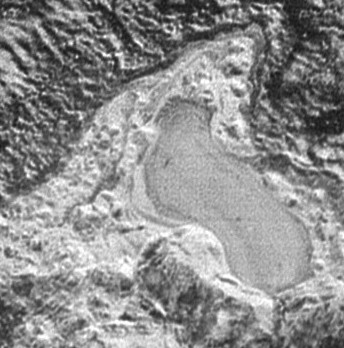By Ana Verayo, | March 29, 2016

Captured by the New Horizons’ Long Range Reconnaissance Imager (LORRI) as the spacecraft flew past Pluto on July 14, 2015, the image shows details as small as about 430 feet (130 meters). At its widest point the possible lake appears to be about 20 miles
New data obtained by NASA's New Horizons mission reveals that Pluto is not only more likely to possess a hidden ocean under its surface, but the dwarf planet could also host lakes on its surface during its recent past and could possibly produce them again in the near future.
Like Us on Facebook
NASA's New Horizons spacecraft recently conducted its flyby of Pluto last July, where data collected from the distant world revealed that on its warmest days, Pluto is still far too cold for its lakes to be composed of flowing water but scientists believe that these lakes can contain liquid nitrogen for longer periods of time when the planet's atmosphere becomes dense.
According to New Horizons mission scientist Richard Binzel from the Massachusetts Institute of Technology, Pluto takes 248 years to complete one full orbit around the sun that also possesses an extreme axial tilt of 120 degrees, producing broader tropical latitudes than Earth, compared to our planet which has a 23 degrees axial tilt. This also means that Pluto's regions are composed of extreme climates where arctic and tropical zones can extend over wide regions of the surface of the dwarf planet.
Apart from this, Pluto also has distinct wobble that causes its axis to tilt an additional 20 degrees from its current position which can cause climate cycles that can last a very long time than on Earth, Binzel adds.
To date, Pluto is now in its intermediate phase shifting between its two extreme climates where its last peak occurred not more than 1 million years ago, where temperatures today average at minus 400 degrees Fahrenheit.
According to New Horizons principal investigator, Alan Stern from the Southwest Research Institute, these variations of the amount of sunlight that hits Pluto's surface directly impacts its atmosphere. The atmospheric pressure today is low where in the past, it could possibly 1,000 to 10,000 times higher, which is 40 times greater than Mars' atmospheric pressure.
In this new study, computer models reveal that liquid nitrogen can be produced when Pluto's temperature and atmospheric pressure are high.
High resolution images from New Horizons also reveal that the dwarf planet's surface features appear to be formed by liquids where the images show a frozen lake that measures 20 miles across located near the northern region Sputnik Planum or Pluto's "heart". This new study will be published in the journal Icarus.
-
Use of Coronavirus Pandemic Drones Raises Privacy Concerns: Drones Spread Fear, Local Officials Say

-
Coronavirus Hampers The Delivery Of Lockheed Martin F-35 Stealth Fighters For 2020

-
Instagram Speeds Up Plans to Add Account Memorialization Feature Due to COVID-19 Deaths

-
NASA: Perseverance Plans to Bring 'Mars Rock' to Earth in 2031

-
600 Dead And 3,000 In The Hospital as Iranians Believed Drinking High-Concentrations of Alcohol Can Cure The Coronavirus

-
600 Dead And 3,000 In The Hospital as Iranians Believed Drinking High-Concentrations of Alcohol Can Cure The Coronavirus

-
COVID-19: Doctors, Nurses Use Virtual Reality to Learn New Skills in Treating Coronavirus Patients







